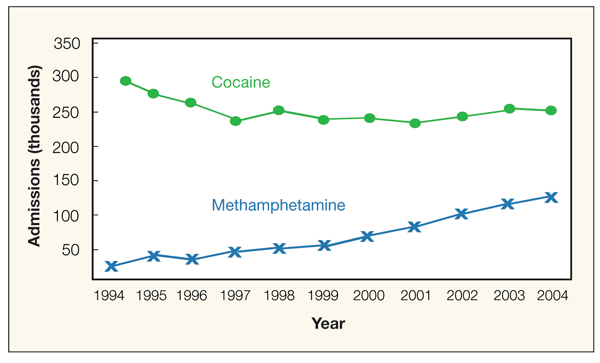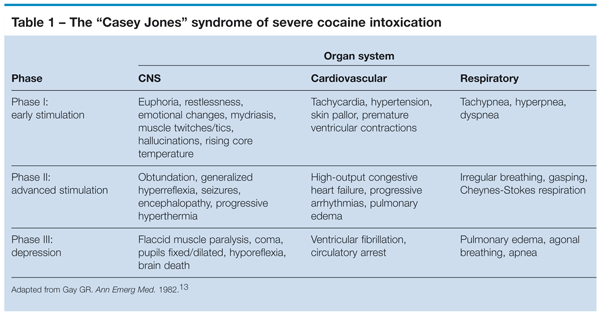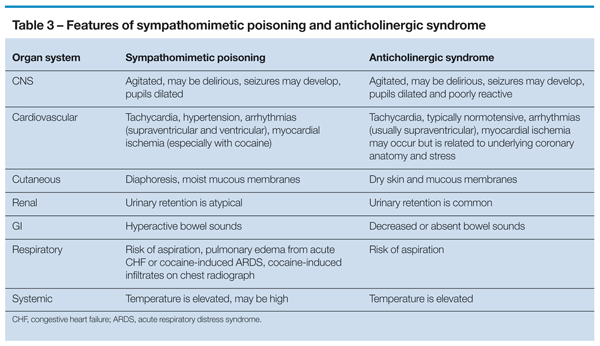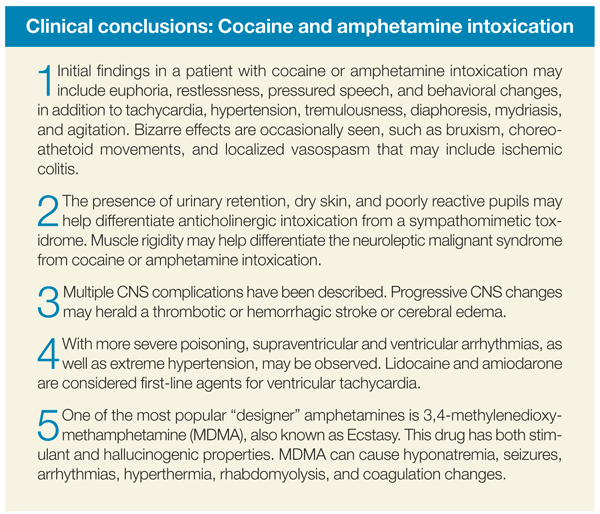- Clinical Technology
- Adult Immunization
- Hepatology
- Pediatric Immunization
- Screening
- Psychiatry
- Allergy
- Women's Health
- Cardiology
- Pediatrics
- Dermatology
- Endocrinology
- Pain Management
- Gastroenterology
- Infectious Disease
- Obesity Medicine
- Rheumatology
- Nephrology
- Neurology
- Pulmonology
Intoxication with street drugs: Cocaine and amphetamines
Cocaine and amphetamine intoxication continue to be common causes of emergency department and hospital admissions.
ABSTRACT:Cocaine and amphetamine intoxication continue to be common causes of emergency department and hospital admissions. The differential diagnosis includes hypoglycemia, hyperglycemia, hypoxia, metabolic encephalopathy, and thyrotoxicosis, as well as other drug intoxications. The presence of hyponatremia may be a clue to the use of one of the "designer" amphetamines, which have both stimulant and hallucinogenic properties. The mainstay of initial management is adequate sedation with a rapid-acting benzodiazepine, which may also help reduce blood pressure and control tachycardia. Treatment may include airway control and interventions to ensure adequacy of oxygenation and ventilation and management of hypertensive emergencies, severe tachycardia, arrhythmias, seizures, hyperthermia, and life-threatening acid-base or electrolyte defects. (J Respir Dis. 2009;30[1])
Illicit recreational use of cocaine and amphetamines, as well as a variety of other “street drugs,” continues to be an overwhelming problem. The use of amphetamines, including crystal methamphetamine, has become extremely common in urban areas. In some cities, the use of amphetamines surpasses that of cocaine.
Some “designer” amphetamines, or entactogens, have become very popular, especially among young persons. Other drugs and plant or fungal products used recreationally include mahuang, cannabinoids, lysergic acid diethylamide (LSD), mescaline, phencyclidine, ephedra, γ-hydroxybutyrate, khat, and psilocybin. Addiction to opiates, especially heroin, remains an international problem.
In this article, we will focus on the critical problems associated with cocaine and amphetamine intoxication, with particular attention given to the identification and management of the sympathomimetic toxidrome that can be produced by use of these agents. We also will discuss other common drugs of abuse, such as the designer amphetamines and hallucinogens.
HISTORICAL TRENDS
Cocaine use has a long history; the coca plant (Erythroxylon coca) has been used in South America for religious and medicinal purposes for more than 3000 years.1 The leaves may be chewed or brewed in a tea. In 1860, a German chemist isolated the pure alkaloid, and a variety of products, including cola, that contained cocaine were sold in the United States and Europe. However, the potential for abuse and addiction was recognized, and cocaine was banned in the United States in 1914. Since that time, it has been widely popular as an illicit recreational agent.
Amphetamines and cocaine share many pharmacological properties. In 1887, benzedrine was the first amphetamine produced synthetically and was used as a decongestant. In the early and mid-20th century, benzedrine and other agents were commercially available as treatments for asthma, headache, and fatigue and were used as an aid to maintain alertness, as well as for a variety of other purposes. The amphetamines were frequently abused, particularly methamphetamine or phenylethylamine amphetamine-commonly termed “speed.”
Newer amphetamines include the designer agents, which have hallucinogenic properties and clinical features that are similar to those of mescaline and serotonin-like agents. There is a cottage industry for the synthesis of these agents. Amphetamines, especially methamphetamine, are relatively easily manufactured from cold remedies in primitive home laboratories or in large, sophisticated illicit manufacturing sites. This industry not only has increased the availability of these drugs but also has increased the risks of explosions, fires, and exposures to various organic or heavy metal toxins that are used in the manufacturing process.
Before the mid-1980s, the main routes of administration of cocaine were intravenous and intranasal. Currently, cocaine is being used predominantly by the oral, nasal, mucosal, and inhalational routes rather than intravenously. Smoking is still one of the most popular methods of using cocaine. Amphetamines have been inhaled, smoked, ingested, or injected. Intranasal use, or “snorting,” is now common, and it leads to a rapid psychological high.
Cocaine and amphetamine abuse are extremely prevalent. In 2004, the National Survey on Drug Use and Health reported that more than 34 million US residents older than 12 years had used cocaine and that nearly 8 million had used crack, with 5.6 million persons using cocaine annually and 1.3 million persons using crack annually.2 Approximately 2 million persons indicated that they currently used cocaine, of whom about 460,000 were using crack. There is also a disturbing trend of younger age at onset of use.
Although cocaine remains very popular, methamphetamine has been overtaking it.3,4 A review of emergency department (ED) admissions from 1994 to 2004 showed a consistent rise in methamphetamine-related admissions that approached that of cocaine (Figure).5 In some regions, methamphetamine use exceeds that of cocaine, and it is estimated that more than 10 million persons aged 12 years or older have used methamphetamine at least once. The age at onset of use continues to decline.

Figure – Cocaine and methamphetamine emergency department admissions in the United States from 1994 to 2004 are shown here. Methamphetamine admissions increased, while cocaine admissions remained relatively stable. (From Substance Abuse and Mental Health Services Administration. 2008.5)
With the dramatic increase in use, there has been a corresponding increase in ED and hospital admissions related to cocaine and amphetamine intoxication. In urban areas, 5% or more of all ED visits may be related to these intoxications. The neurobehavioral changes related to excessive stimulation by these agents are a major cause of mortality. As many as two-thirds of deaths related to cocaine use in young adults may be the result of traumatic injuries, with the remainder being directly related to the effects of intoxication.6
PHARMACOLOGY
Cocaine (benzoylmethylecgonine) is an alkaloid from the coca plant. The 2 major forms are cocaine hydrochloride and freebase crack-cocaine. Cocaine combined with heroin is termed “speedballing”; when mixed with alcohol, it is referred to as “liquid lady.” When used together, cocaine and alcohol produce the metabolite cocaethylene, which has increased toxicity and can cause depression of left ventricular function.
Amphetamines are derivatives of phenylethylamine. They share similar chemical structures with epinephrine and with naturally occurring catecholamines and other sympathomimetic amines. They share a benzene ring and an ethylamine chain. Substitutions on the benzene ring and variations in the side chain result in differences in pharmacological properties, with selective effects on α- and β-adrenergic activity as well as on CNS activities. Barger and Dale7 evaluated the chemistry and pharmacology of synthetic amines related to epinephrine and coined the term “sympathomimetic” to describe the properties of these agents.
The pharmacology of cocaine and that of methamphetamine are similar in many respects. Cocaine acts on both the peripheral and central nervous systems; applied locally, it is an anesthetic. The autonomic nervous system effects of cocaine and amphetamines relate to their α2-adrenergic receptor agonism. These receptors block catecholamine reuptake, which results in increased activation of the sympathetic nervous system. CNS stimulation occurs, in part, because of dopaminergic stimulation. At high doses, amphetamines also release serotonin, particularly in the CNS. This effect may be responsible for the hallucinogenic properties of some of the amphetamines.
Cocaine effects are rapid and relatively short-lived. Amphetamines tend to have a longer duration of action, sometimes up to 24 hours. Vasospasm related to sympathetic stimulation may lead to regional ischemia, and necrotizing vasculitis has been seen with amphetamines, particularly after parenteral use.8,9
Withdrawal from cocaine is associated with catecholamine depletion, dehydration, sleepiness, bradycardia, and occasionally choreoathetoid movements (“crack dancing”) related to dopamine changes. In addition, depression, paranoid thoughts, and irritability may be seen. Withdrawal from amphetamines is similar, with tremor, chills, lethargy, and increased sleep.
METABOLISM
Cocaine enters the circulation rapidly after smoking or intramucosal application. It is hydrolyzed by plasma pseudocholinesterase or liver esterases to ecgonine, ecgonine methyl ester, and benzoylecgonine. These relatively inactive products are excreted in the urine. Plasma clearance half-life after intravenous injection or smoking is about 60 to 90 minutes. The hepatic cytochrome P-450 enzyme system of metabolism leads to the formation of highly reactive compounds that produce liver damage, neurotoxic effects, and macrophage dysfunction.
Amphetamines are lipophilic and have large volumes of distribution. They are predominantly deaminated by cytochrome P-450 enzymes and are eliminated by renal and hepatic mechanisms. Up to 50% of elimination of methamphetamine is by renal mechanisms.
METHODS OF DETECTION
Urine drug assay is the most facile method to detect cocaine use. Since blood levels of cocaine are short-lived-approximately 1 hour-blood toxicology studies are seldom used. However, cocaine metabolites rapidly appear in the urine. After an intravenous or intranasal dose of cocaine, its metabolites, especially benzoylecgonine, can be detected in the urine within 5 minutes. After a single use of cocaine, test results for urine metabolites are positive for 48 to 72 hours, as detected by rapid, visually read immunoassays. With long-term use, the urine drug screen findings may be positive for up to 3 weeks after the last dose.
Qualitative urine immunoassays for amphetamines have been developed, but results are not usually available for several hours, which limits clinical use. In addition, previous use of cold remedies may cause false-positive results. Gas chromatography techniques yield quantitative and qualitative results, but turnaround times and expense are factors that limit their use.
Blood test results may be positive for amphetamines for hours. However, the clinician usually must make diagnostic and therapeutic decisions for cocaine and amphetamine intoxications primarily on the basis of historical features and the clinical presentation and course.
CLINICAL FEATURES
Toxicity is related to intense and uncontrolled stimulation of the sympathetic nervous system.10 There are progressive stimulatory effects on the cardiovascular system and the CNS, with sympathetic-mediated activities resulting in cardiovascular complications, seizures, and hyperthermia. The cardiovascular and CNS effects are dose-related.
Initial findings include euphoria, restlessness, pressured speech, and behavioral changes, in addition to tachycardia, hypertension, tremulousness, diaphoresis, mydriasis, and agitation. Bizarre effects are occasionally seen, such as bruxism, choreoathetoid movements, and localized vasospasm that may include ischemic colitis. Seizures and cardiac ischemia and arrhythmias are more common in cocaine users than in amphetamine users.11 The mechanisms of fever are multifactorial and include direct action on the hypothalamus, increased motor activity, and severe peripheral vasoconstriction despite diaphoresis, leading to decreased cooling.12
We suggest the use of a mnemonic to identify the typical clinical features of the sympathetic toxidrome: “the rat from hell,” or HADES RAT: H-hypertension; A-agitation; D-delirium; E-eyes (dilated); S-seizures; R-rhabdomyolysis; A-arrhythmias; T-temperature (hyperthermia).
A progressive syndrome of severe cocaine intoxication was described by ED physicians who observed multiple cases in San Francisco.13 This is based on clinical features of rapidly progressive intoxication as manifested by CNS, circulatory, and respiratory features. The syndrome was likened to the children’s book about Casey Jones, a post–Civil War locomotive engineer who drove his train faster and faster until it crashed.14 The 3 successive stages of the syndrome are shown in Table 1.

DIFFERENTIAL DIAGNOSIS
Other conditions that may lead to an adrenergic storm, such as thyrotoxicosis or an anticholinergic crisis, should be considered in the differential diagnosis of cocaine or amphetamine intoxication. Conditions that may share some features, particularly CNS alterations, with cocaine or amphetamine intoxication are shown in Table 2.

The presence of urinary retention, dry skin, and poorly reactive pupils may help differentiate anticholinergic intoxication from a sympatomimetic toxidrome (Table 3). The neuroleptic malignant syndrome may have features similar to those of intoxication, but the historical features and muscle rigidity may help differentiate it from cocaine or amphetamine poisoning.

MANAGEMENT
Patients with suspected cocaine or amphetamine toxicity should be rapidly evaluated with a priority-based plan of management. Agitated patients must be adequately sedated with benzodiazepines and protected from harming themselves or others. Lifesaving actions include airway control and interventions to ensure adequacy of oxygenation and ventilation, as well as management of hypertensive emergencies, severe tachycardia, seizures, arrhythmias, hyperthermia, and life-threatening acid-base or electrolyte defects.
As these maneuvers are conducted, a battery of laboratory and imaging techniques are assembled for monitoring the patient. Steps of initial management and evaluation procedures are listed in Table 4.
CNS effects
Multiple CNS complications of cocaine and amphetamine intoxication have been described. Control of agitation, delirium, and seizures is paramount. Progressive CNS changes may herald a thrombotic or hemorrhagic stroke or cerebral edema.
The mainstay of initial management should be adequate sedation using intravenous doses of a rapid-acting benzodiazepine, such as lorazepam or midazolam, which may also help reduce the patient’s blood pressure and control tachycardia. Haloperidol and other antipsychotic agents are usually avoided because of the possible risk of seizures or the effects on temperature control and arrhythmias.
Temperature control is frequently disturbed, and severe hyperthermia should be treated appropriately, with passive and, on occasion, active cooling measures. Fluid administration is also crucial for controlling fever.
When the patient is sufficiently stable for transport, it is appropriate to consider obtaining CT scans of the head, chest, and abdomen, particularly in the presence of seizures, severe hypertension, and/or focal neurological findings.
Cardiovascular problems
Tachycardia and hypertension are almost universal findings in even mild to moderate intoxication. The primary management at this stage is sedation with benzodiazepines. Continuous ECG monitoring, echocardiography, and serial assessment of levels of cardiac enzymes are indicated.
With more severe poisoning, supraventricular and ventricular arrhythmias, as well as extreme hypertension, may be observed. Lidocaine and amiodarone are considered first-line agents for ventricular tachycardia. Sotalol also is an option. Caution should be used with amiodarone and sotalol if there is QT prolongation (which may occur with cocaine use) because of the risk of torsade de pointes.
Some authorities recommend avoiding combined blocking agents such as labetalol because these agents reduce systemic blood pressure but do not alleviate coronary vasoconstriction.15 Previous reports suggested that β-blockers be avoided in the management of cocaine toxicity because of the risk of β blockade potentiating coronary vasospasm.16,17 However, recent studies have challenged this approach and indicate that β-blockers may be used in managing of cocaine toxicity associated with coronary ischemia.18,19 Thus, the use of β-blockers in this setting is controversial; more studies are needed to resolve this issue.
Long-term use of cocaine accelerates atherosclerosis. Accordingly, patients may have classic signs of myocardial ischemia and infarction, but coronary angiography may not demonstrate obstruction.
Nitrates, calcium channel blockers, and opiates may be used. In emergency situations, nitroprusside may be used to temporarily and rapidly control the patient’s blood pressure. Phentolamine is effective in managing a stimulation, lowering blood pressure, and managing myocardial ischemia.
Because cocaine induces platelet aggregation, heparin and/or thrombolytic therapy (standard protocols) may be used, although the clinician should ensure that there are no intracranial, aortic, or other vascular lesions, which would contraindicate anticoagulation.16,20-22
There are several reports of aortic dissection as well as CNS hemorrhages associated with these drug intoxications.
Pulmonary complications
Hyperpnea and tachypnea are seen in even mild intoxications. Aspiration pneumonitis is a risk, particularly with severe CNS effects, such as seizures and coma. On occasion, reactive airway syndromes may be seen. Endotracheal intubation should be strongly considered in patients with marked CNS changes.
Cocaine abuse may induce acute respiratory distress syndrome and noncardiogenic pulmonary edema, as well as patchy infiltrates on the chest radiograph. Cardiogenic pulmonary edema can result from hypertensive crisis or myocardial ischemic syndromes. In addition to routine chest radiography, cardiac monitoring, echocardiography, and invasive cardiovascular monitoring should be considered in such instances.
Metabolic effects and temperature
Diaphoresis and fever, as well as decreased intake, vomiting, or diarrhea, frequently lead to hypovolemia. Electrolyte defects, particularly potassium loss, may be seen; hyponatremia may suggest designer amphetamine intoxication. Therefore, although blood pressure is likely to be high, many patients require intravenous fluids. In the presence of hypertension and signs of pulmonary edema, fluids should be administered with caution, and the patient’s central venous pressure as well as urinary output should be monitored.
Renal failure, rhabdomyolysis, and multiple electrolyte defects are common in severe intoxication. When rhabdomyolysis is confirmed by a 5-fold or greater increase in creatine kinase level, fluid loading and careful monitoring of renal function and electrolytes are indicated.
Hyperthermia can be a lethal complication and should be treated aggressively. The patient’s core temperature should be monitored and fluids given, with active/passive cooling measures. Controlling CNS and cardiovascular toxicity is crucial as fever is treated.
Severe and progressive toxicity: “body packers”
Transport of cocaine or amphetamines by swallowing to avoid detection by law enforcement poses unique problems.23 Rupture of packets containing a drug may lead to an overwhelming local and systemic reaction. Intestinal ischemia and necrosis may occur, as well as severe cardiovascular and metabolic effects.
Patients who are alert may have abdominal pain or other abdominal findings; in these instances, abdominal radiography may disclose drug packets. However, some packets may not be visualized, and emergency endoscopy or surgery may be required. In asymptomatic patients who have ingested packets, activated charcoal and/or catharsis and watchful waiting are indicated.
OTHER AGENTS
In contrast to the repetitive, often daily use of cocaine or amphetamines for psychological stimulation, many of the designer drugs are used intermittently, such as during parties or for specific purposes (for example, to enhance sexual stimulation or performance), or to produce psychological effects, such as hallucinations or enhanced awareness.11 Some of these agents have substantial risks of addiction and some have pharmacological properties that may lead to life-threatening reactions.
There is considerable misinformation regarding the risks of many of these agents. On the Internet, for example, many entries refute competent research and government data regarding the dangers of these compounds, as well provide information on how to purchase drugs and the associated paraphernalia.
Designer amphetamines
A number of derivatives of amphetamines have been developed that have stimulant and hallucinogenic properties that differ from those of cocaine or methamphetamine. These hallucinogenic amphetamines are known as entactogens.
Two of the more popular drugs are 3,4-methylenedioxymethamphetamine (MDMA) and 3,4-methylenedioxyamphetamine (MDEA). MDMA (commonly known as Ecstasy, XTC, M&M, Eve, or Adam) is the most widely used and is often associated with “rave” parties. It is thought to enhance sexual stimulation as well as have hallucinogenic properties.
MDMA and MDEA have serotonergic properties, which may account for their hallucinogenic potential. However, MDMA and MDEA toxicity also has the features of a sympathomimetic toxidrome, as has been described for other amphetamines.
One feature of MDMA intoxication may be hyponatremia, which is related to vasopressin release and to increased sweating and free water intake from alcohol.11 Seizures are not uncommon with MDMA intoxication and may be related to the CNS effects of the drug as well as to hyponatremia. There is a risk of cardiac arrhythmias, hyperthermia, rhabdomyolysis, and coagulation changes with MDMA.
Aside from specific management for hyponatremia, therapy is otherwise similar to that for other amphetamine intoxications.
Hallucinogens
Many drugs and plant products of diverse chemical structures are hallucinogenic or illusionogenic.24 Some of these agents have addictive properties, but many do not. Mescaline or peyote buttons derived from cactus were originally used for religious ceremonies and then were adopted by the drug culture for illicit use. Chemical and clinical properties of various hallucinogens are shown in Table 5.

• LSD: Also known as acid, LSD is available in a variety of forms, including tablets, liquid, and blotter sheets. Although LSD produces profound psychotropic changes and patients occasionally have panic attacks, patients are usually calm. The sympathomimetic effects are usually milder than those of amphetamines. Hypertension, fever, dilated pupils, and flushing may be seen. In massive ingestions, coma and hypotension may occur. Flashbacks may occur weeks or months after ingestion of LSD.
Management typically involves keeping the patient calm in a protective environment. Sedatives such as benzodiazepines are used as needed for panic attacks.
• Tryptamines: These agents include naturally occurring substances, such as psilocybin and psilocin found in mushrooms; compounds in the parotid glands of toads; and synthesized agents, such as diisopropyltryptamine and derivatives, known as “foxy” or “foxy methoxy.” These substances have serotonergic properties, which account for their hallucinogenic activity. There are no antagonists to these agents, and management consists of sedation and close observation. Reactions usually subside within hours. Benzodiazepines may be helpful.
• Mescaline: This is a hallucinogenic alkaloid from the peyote cactus. It is a phenylethylamine derivative with chemical features similar to those of amphetamines, and it has serotogenic effects. Mescaline frequently causes nausea, vomiting, diaphoresis, and headache. There may be hypertension, tachycardia, and mydriasis. The effects are usually short-lived, and supportive care is usually sufficient.
• Phencyclidine: Also known as PCP or angel dust, phencyclidine is an anesthetic agent similar to ketamine. It may be smoked, sniffed, or injected. The clinical features are variable and include CNS stimulation or depression. Cholinergic, anticholinergic, or sympathomimetic effects may also occur. Nystagmus and hypertension, as well as violent behavior, are frequently reported. Seizures may lead to rhabdomyolysis or aspiration. Management is often challenging and should be tailored to the patient’s signs and symptoms.

References:
1. Weil A. Letters from the Andes: the new politics of coca. New Yorker. May 15, 1995:70-80.
2. US Dept of Health and Human Services, Office of Applied Studies. Results From the 2004 National Survey on Drug Use and Health: National Findings. http://www.oas.samhsa.gov/nsduh/2k4nsduh/2k4results/2k4results.pdf. Accessed April 8, 2008.
3. National Institute on Drug Abuse. Epidemiologic Trends in Drug Abuse: Advance Report, Community Epidemiology Working Group, January 2006. Bethesda, MD: National Institutes of Health, Dept of Health and Human Services; 2006. NIH publication 06–5878.
4. National Institute on Drug Abuse. National Institute on Drug Abuse Research Report Series: Methamphetamine Abuse and Addiction. http://www.drugabuse.gov/PDF/RRMetham.pdf. Accessed April 8, 2008.
5. Substance Abuse and Mental Health Services Administration. Treatment Episode Data Set (TEDS) Highlights-2004. National Admissions to Substance Abuse Treatment Services. http://wwwdasis.samhsa.gov/teds04/tedshigh2k4.pdf. Accessed April 25, 2008.
6. Butterfield F. Drop in homicide rate linked to crack’s decline. New York Times. October 27, 1997. http://query.nytimes.com/gst/fullpage.html?res=9C06EFD81731F934A15753C1A961958260&sec=&spon=&pagewanted=all. Accessed April 8, 2008.
7. Barger G, Dale HH. Chemical structure and sympathomimetic actions of amines. J Physiol. 1910;41:19-59.
8. Bostwick DG. Amphetamine-induced cerebral vasculitis. Hum Pathol. 1981;12:1031-1033.
9. Citron BP, Halpern M, McCarron M, et al. Necrotizing angiitis associated with drug abuse. N Engl J Med. 1970;283:1003-1011.
10. Goldfrank LR, Hoffman RS. Cardiovascular effects of cocaine. Ann Emerg Med. 1991;20:165-175.
11. Chang WK. Amphetamines. In: Goldfrank LR, Flomenbaum NE, Lewin NA, et al, eds. Goldfrank’s Toxicologic Emergencies. 7th ed. New York: McGraw–Hill; 2002:chap 68.
12. Crandall CG, Vongpatanasin W, Victor RG. Mechanism of cocaine-induced hyperthermia in humans. Ann Intern Med. 2002;136:785-791.
13. Gay GR. Clinical management of acute and chronic cocaine poisoning. Ann Emerg Med. 1982;11:562-572.
14. York CB. Casey Jones. Mahwah, NJ: Troll Associates; 1980.
15. Boehrer JD, Moliterno DJ, Willard JE, et al. Influence of labetalol on cocaine-induced coronary vasoconstriction in humans. Am J Med. 1993;94:608-610.
16. Hollander JE. The management of cocaine-associated myocardial ischemia. N Engl J Med. 1995;333:1267-1272.
17. Lange RA, Cigarroa RG, Flores ED, et al. Potentiation of cocaine-induced coronary vasoconstriction by beta-adrenergic blockade. Ann Intern Med. 1990;112:897-903.
18. Dattilo PB, Hailpern SM, Fearon K, et al. Ã-Blockers are associated with reduced risk of myocardial infarction after cocaine use. Ann Emerg Med. 2008;51:117-125.
19. Freeman K, Feldman JA. Cocaine, myocardial infarction, and Ã-blockers: time to rethink the equation? Ann Emerg Med. 2008;51:130-134.
20. Hollander JE, Hoffman RS, Burstein JL, et al. Cocaine-associated myocardial infarction. Mortality and complications. Cocaine-Associated Myocardial Infarction Study Group. Arch Intern Med. 1995;155:1081-1086.
21. Gitter MJ, Goldsmith SR, Dunbar DN, Sharkey SW. Cocaine and chest pain: clinical features and outcome of patients hospitalized to rule out myocardial infarction. Ann Intern Med. 1991;115:277-282.
22. Zafar H, Vaz A, Carlson RW. Acute complications of cocaine intoxication. Hosp Pract (Minneap). 1997;32:167-170, 175-177, 181.
23. Traub SJ, Hoffman RS, Nelson LS. Body packing-the internal concealment of illicit drugs. N Engl J Med. 2003;349:2519-2526.
24. Hansen KN, Prybys KM. Hallucinogens. In: Tintinalli JE, Kelen GD, Stapczynski JS, eds. Tintinalli’s Emergency Medicine: A Comprehensive Guide. 6th ed. New York: McGraw-Hill; 2002:chap 169.
